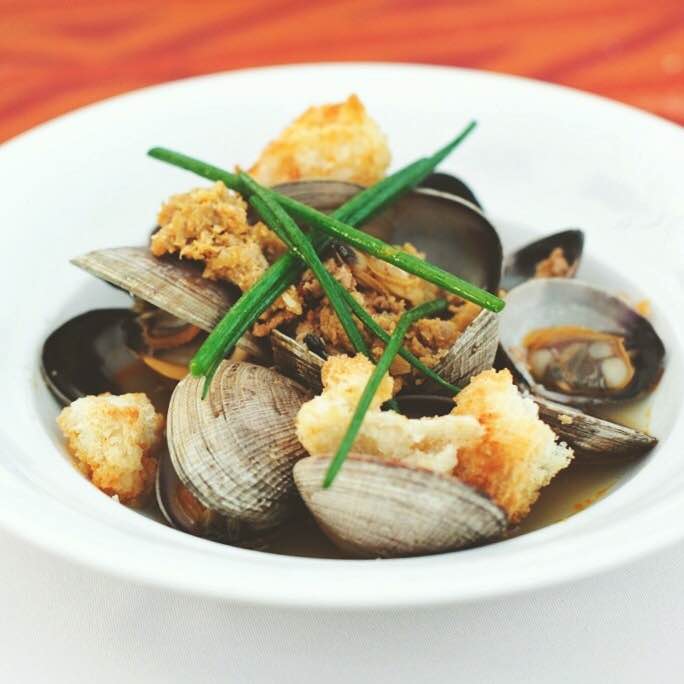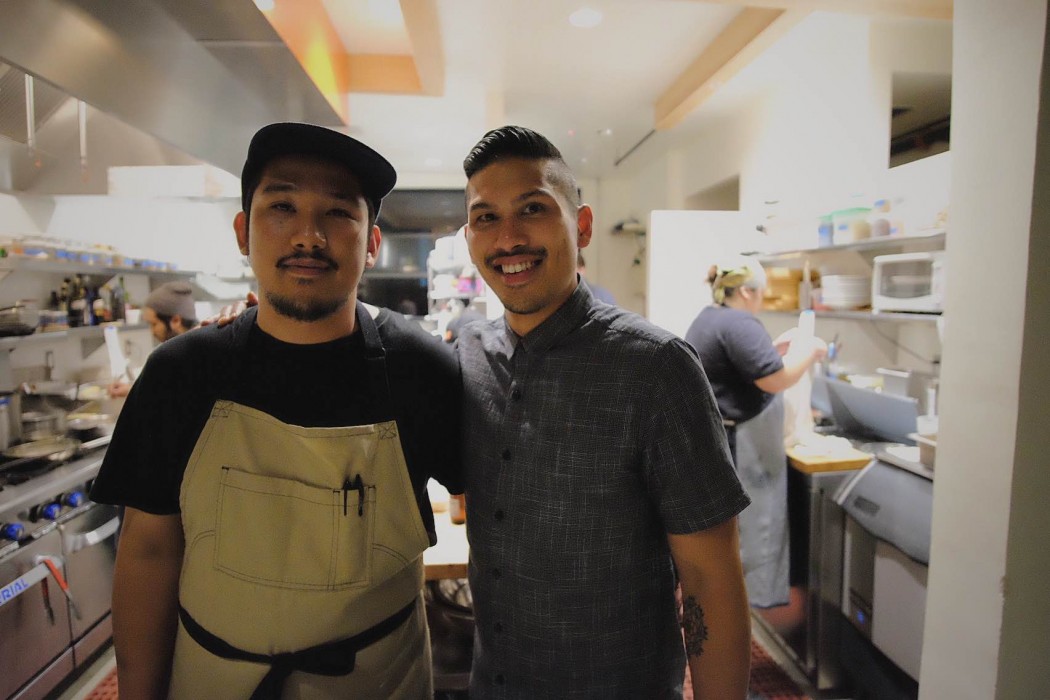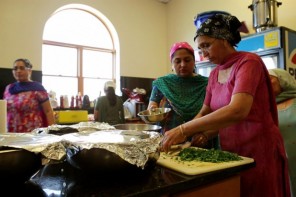There have been quite a few trends gaining traction in the L.A. culinary scene. Filipino food and pop-up dinners are among two of them. And for the Valencia brothers—Chase, 31, and Chad, 30—it was the perfect way to introduce Filipino food to mainstream diners. Both have more than a decade of restaurant experience under their respective belts: Chase on the operations side, most notably with Wolfgang Puck Catering, and Chad behind the scenes as a chef in the kitchens of Canelè and Sqirl. LASA was born in 2013, when they began organizing monthly pop-up dinners that featured food inspired by Philippine cuisine and influenced by the seasonality of Southern California’s farmers markets. Items on past menus have included octopus adobo, braised duck arroz caldo, toyomansi-braised short ribs, flat iron steak with bagoong butter, and a chilled avocado custard with calamansi and condensed milk. http://www.lasarestaurant.com
—Lisa and Irene Yadao
Q: Where did you grow up and how did Filipino food fit into your childhoods and adulthoods?
A: Chad and I were both born in Los Angeles and have lived in Southern California most of our lives. Filipino food has always been a big part of our lives and it’s what we grew up eating. Filipino food was for breakfast, lunch and dinner. Of course we would dine out, but at home it was mainly Filipino food. Our family is from a province in the Philippines called Pampanga, a region with a strong culinary history. Some dishes in the Filipino cuisine canon originated from our province—foods like sisig and bringhe. With that, our family has a lineage of some great cooks—our mom, grandmothers, great grandmothers and other aunts. We took the memories and flavors of what we grew up with, combined it with [new] ingredients, and applied techniques learned from time spent in California restaurant kitchens.
Q: How did you come to realize there was a market or a need for your dishes?
A: The restaurants out there were run by my parents’ generation, [people] who immigrated here. These restaurants were more of a fast casual or turo-turo type experience. We felt Filipinos wanted to taste our cuisine in a different way, [wanted us to] take our flavors and present them from a different perspective. Especially for a growing second-generation Filipino American community, we understand they wanted something else. California has incredible ingredients and we wanted to highlight that with Filipino flavors (and vice versa). In Los Angeles, there were quite a few turo-turo, fast casual and Fil-Am food trucks doing Filipino food. But there wasn’t a more chef-driven Filipino-focused restaurant concept in L.A. There was too big of a culinary void when it came to Filipino food, and we believed our concept and food would make sense. Efforts made by others in the Filipino food community played a large part in our push as well—[people who opened] restaurants like Maharlika/Jeepney and Kuma Inn in New York; Burnt Lumpia, Manila Machine, and White Rabbit in Los Angeles; The Attic in San Francisco; and Lamesa in Toronto to name a few. Seeing how well people responded to their projects proved that there is an interest in Filipino food.
Q: How is your food received by both the Fil-Am community and non-Filipinos?
A: The Fil-Am community is very excited about our project and really enjoy our food. The feedback from guests is that we’re elevating our cuisine, keeping the flavors of Filipino food but presenting it in a different way; some say they never thought Filipino food could be done like this. Some [non-Filipinos] have had Filipino food but most have not and are curious diners. Through the course of the meal, diners get really into it, asking questions about the ingredients, about how the food is prepared and about Filipino food and culture. It’s as if we’re introducing them to Filipino food for the first time. We’re happy it’s with us.
Q: What is one dish you feel best represents the Philippines and why?
A: Sinigang best represents Filipino food to me. Our food is often times soup-based, simple, rustic and often includes cheap cuts. In other words, it’s third-world world soul food. Filipino food can be both tangy and earthy. For me sinigang does that—the sour notes of the tamarind-based broth with your choice of protein (beef or fish) and some hearty vegetables represents the flavors of Filipino food.
Q: What trends are you noticing with Filipino food, whether it’s a dish that’s gaining popularity or chefs trying new twists on old traditions?
A: The major trends I’m seeing are chefs taking food, recipes and ingredients from the Philippines and making it their own. It’s fun seeing what ideas chefs are coming up with. Another major trend I see is the “kamayan” experience. I believe Jeepney in New York popularized the style of eating [in the United States] and I see it across the country. People are into it and have fun with it.
Q: In America, we’re used to seeing other Asian foods on menus across the country, yet there hasn’t been that same kind of accessibility to Filipino food. But now there seems to be a growing number of restaurants, food trucks, pop-ups featuring Filipino cuisine. What can this shift be attributed to?
A: We believe there are two major reasons helping with the popularity of Filipino food—the first is that second generation Fil-Ams are embracing the cuisine and want to cook and share the food we grew up with. It’s exciting. We have a lot of Filipinos in the restaurant industry and it’s about time we make an effort to cook our food. I believe there is a larger mental shift happening in the Fil-Am psyche, especially among the second generation who want to give our food a fair shot. In the past, chefs didn’t think it was a serious cuisine. We are no longer shy or ashamed of our food. Our community has moved past the “assimilation” aspect of our Fil-Am culture, and we are now at a phase of embracing and owning our identity. The second major factor is social media. Filipino Food Movement and other Filipino food-oriented social media accounts have been instrumental in promoting our cuisine and connecting all of the chefs, trucks, projects, and pop-ups. Although I am not in NYC, SF, Philly, DC, Chicago, Seattle or New Orleans everyday, I know there are folks out there putting their passion on the plate and we are inspiring each other. Social media plays a large part in keeping a lot of us together and promoting our food.
Q: What are some misconceptions, if any, about Filipino food?
A: Back then, the biggest misconception was the feeling that there was no reason to go out and eat at a Filipino restaurant establishment because people in the Filipino community always argued—“Why do I have to go out and eat Filipino Food when my mom/grandma/aunt cooks the best?” That way of thought really stifled any creative development in our cuisine and even discouraged chefs from seriously pursuing cooking Filipino food. In large part, that caused our food to stay at home. Now, people are seeing that [Filipino] chefs are passionate and proud of Filipino Cuisine; and now people are curious and open minded to check them out.
Q: How would you like the future of Filipino food in America to look?
A: We’re looking forward to [seeing an increase in] the different types of Filipino restaurant experiences available— like Italian food’s proliferation of pizzerias, trattorias, fast casual, sit down, upscale, etc. We would love for Filipino food to go that route in some capacity. There is not just one type of Filipino food experience out there anymore, and it’s exciting.

Lasa’s San Miguel Steamed Manila Clams
Cooking time may vary 2 hours and 30 minutes prep and 1 hour cooking should be enough.
YOU WILL NEED…
FOR THE LONGANISA:
1lb (45g) Pork shoulder (grinded in meat grinder)
6 Garlic cloves (minced)
2 Tbsp Black peppercorns (toasted and grinded)
2 Tbsp Annatto seed (ground)
1 Tbsp Pimenton
2 Tbsp Brown Sugar
1 Tbsp Rice Wine Vinegar
Salt (to taste)
FOR THE CROUTONS:
Day old or stale Pan De Sal
Grape-seed Oil
Salt
FOR THE CLAMS:
2lbs (90g) Manila Clams (cleaned)
1 Shallot (sliced)
1 Bottle San Miguel Pale Pilsen
1/2 Cup fish stock or clam juice
2 Tbsp Butter
Calamansi or Lime (fresh)
Chives
LET’S GET STARTED!
FOR THE LONGANISA:
Mix ground pork and various ingredients very well by hand. Season with salt to taste. Refrigerate for at least an hour or two.
FOR THE CROUTONS:
Hand tear day old pan de sal. Toss in neutral oil such as grape-seed and season lightly with salt. Toast in preheated 350 degree oven until golden brown.
FOR THE CLAMS:
Heat large pan with splash of grape-seed oil on medium high. Brown shallots and longanisa together. Add Clams, bottle of San Miguel and fish stock. Cover pot until clams open. Remove from heat, stir in butter.
GARNISH WITH PAN DE SAL CROUTONS AND CHIVES. ADD A SQUEEZE OF FRESH CALAMANSI.
+ + +
 This story is a part of Off the Menu: Asian America, a multimedia project between the Center for Asian American Media and KQED, featuring a one-hour PBS primetime special by award-winning filmmaker Grace Lee (American Revolutionary: The Evolution of Grace Lee Boggs), original stories and web content.
This story is a part of Off the Menu: Asian America, a multimedia project between the Center for Asian American Media and KQED, featuring a one-hour PBS primetime special by award-winning filmmaker Grace Lee (American Revolutionary: The Evolution of Grace Lee Boggs), original stories and web content.




